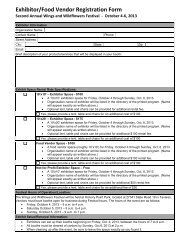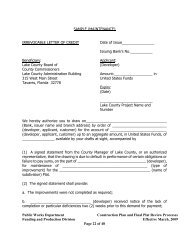Mosquito Management Procedures - Lake County
Mosquito Management Procedures - Lake County
Mosquito Management Procedures - Lake County
You also want an ePaper? Increase the reach of your titles
YUMPU automatically turns print PDFs into web optimized ePapers that Google loves.
<strong>Mosquito</strong> <strong>Management</strong> <strong>Procedures</strong><br />
<strong>Mosquito</strong> management is a multi-disciplinary subject that combines the art of understanding<br />
mosquito behavior with the science of knowing how to locate and control mosquito populations. All<br />
mosquito management programs worldwide have their own unique control measures for their own<br />
specific management problems. However, the primary goal of all mosquito management programs<br />
is to enhance the health and comfort of the citizens.<br />
As with all career fields, the mosquito control industry has its own specific terminology. The<br />
following is a list of some of the more common terms.<br />
• Adulticide: an insecticide used to kill adult insects.<br />
• Larvicide: an insecticide used to kill larval (immature) insects.<br />
• Ultra Low Volume: commonly known as ULV, a method of applying adulticides at volumes<br />
less than 10 ounces per acre.<br />
• Thermal Fog: commonly known as fogger, a method of applying adulticides mixed with a<br />
carrying agent, usually diesel fuel, and heating it to form a fog.<br />
• Drift: the direction and distance the spray travels after leaving the spray head.<br />
• Crepuscular: the hours between one-half hour before and after sunset and one-half hour<br />
before and after sunrise.<br />
• Atomize: to reduce to minute particles or a fine spray.<br />
• Landing Rate: a surveillance method used to determine adult mosquito populations by<br />
counting the mosquitoes that land on the front half of your body for one minute.<br />
<strong>Mosquito</strong> Biology<br />
There are approximately 45 different species of mosquitoes in <strong>Lake</strong> <strong>County</strong>. However, only a few of<br />
these species have the potential of transmitting diseases and, therefore, are a primary concern for<br />
management purposes.<br />
<strong>Mosquito</strong> Species of Primary Concern<br />
Aedes aegypti<br />
Aedes albopictus<br />
Aedes vexans<br />
Anopheles crucians<br />
Anopheles quadrimaculatus<br />
Culiseta melanura<br />
Coquillettidia perturbans<br />
Mansonia dyari<br />
Mansonia titillans<br />
Culex nigripalpus<br />
Culex quinquefasciatus<br />
Culex salinarius<br />
<strong>Mosquito</strong> eggs are generally cylindrical in shape, tapered at the top and rounded at the bottom. Each<br />
mosquito species prefers certain localities for depositing eggs. Some prefer very clean water, others<br />
slightly polluted water, while others thrive in extremely polluted water. There are five distinct types<br />
of oviposition:
• Single On Water: Anopheles and Toxorhynchites lay their eggs one at a time on the water<br />
surface.<br />
• Single In Soil: most Aedes and Psorophora lay their eggs one at a time on a moist substrate,<br />
such as mud and decomposing leaf litter.<br />
• Single On Cavity Walls: Wyeomyia, Orthopodomyia, and certain Aedes deposit eggs in tree<br />
holes, water-holding plants, or artificial containers. The eggs are placed just above the<br />
waterline.<br />
• Rafts On Water: Most Culex, Culiseta, Coquillettidia, and Uranotaenia lay eggs in masses,<br />
called rafts or boats, on the water surface.<br />
• On Plants: Mansonia eggs are deposited on the underside, and sometimes on top, of the<br />
leaves of certain floating aquatic plants.<br />
<strong>Mosquito</strong> larvae live in water and have four developmental periods called instars. Each successive<br />
instar is larger than the previous one. Larvae feed aggressively until the late fourth instar.<br />
The mosquito pupae are the next stage of development. Pupae react similar to larvae by diving to<br />
the bottom when the surface is disturbed or there are changes in illumination. Because pupae do not<br />
feed, water quality is of little importance for survival, as long as the surface is free of oils that<br />
suffocate the insect.<br />
The male mosquito develops slightly faster than the female. Sometimes, the male emerges from the<br />
pupae stage a day or so earlier than the female in many species. The adult mosquito has three body<br />
parts: the head, thorax, and abdomen. The major difference between the male and female mosquito<br />
is the male has large, bushy palpi protruding from its head.<br />
Adult <strong>Mosquito</strong> Activity<br />
All mosquito species have their own specific behavioral patterns that influence activity. However,<br />
environmental factors seem to have a more dramatic affect on mosquito activity.
Studies have shown that the majority of mosquito activity occurs at night with over half of this<br />
activity occurring during the crepuscular periods. Also, one study showed that up to five times as<br />
many mosquitoes are in flight during a "full moon" when compared to a "new moon". Only a few<br />
mosquito species are active during the daylight hours.<br />
Temperature plays an important role in mosquito activity. At 68 o F mosquitoes in flight begin to<br />
decrease and are almost nonexistent at 50 o F. Relative humidity also has an effect on mosquito<br />
activity. A burst of activity occurs when the humidity reaches 90% and peaks during light showers.<br />
However, mosquitoes seek shelter during heavy rain and are rarely in flight.<br />
<strong>Mosquito</strong>-Borne Diseases<br />
St. Louis encephalitis (SLE) is a mosquito-transmitted virus that is considered to be of greatest<br />
medical importance in North America. During epidemics, large numbers of people become<br />
seriously ill, sometimes fatally.<br />
The transmission cycle of SLE is thought to accompany infection of various species of wild birds. It<br />
takes about 1-2 days after a bird is infected by a mosquito bite to produce enough viruses in its<br />
blood to infect other mosquitoes that might feed upon it. The virus disappears about 1-3 days later<br />
as the bird recovers. This provides a narrow "window of opportunity" for mosquitoes to pick up the<br />
virus and further spread it. After a bird has been infected with SLE, it is immune from another<br />
infection.<br />
The mosquito Culex nigripalpus has been linked to past SLE epidemics in Florida. Other species<br />
that may be involved in SLE transmission but have not, as yet, been implicated are Culex<br />
quinquefasciatus, Culex salinarius, and Culex restuans. SLE transmission to birds and humans is<br />
most likely to occur from August through November. Populations of Culex nigripalpus tend to<br />
reach their annual peak during this period. Transmission to birds seems to increase when subsequent<br />
heavy rains break long periods of drought.<br />
There is no vaccine to protect against SLE infection. Also, like all virus infections, SLE cannot be<br />
cured. Therefore, the best prevention is to suppress the mosquito populations that may transmit the<br />
virus.<br />
- - - - -<br />
Eastern equine encephalitis (EEE) is a fatal disease of horses and humans caused by a virus carried<br />
by mosquitoes. The disease occurs throughout the eastern U.S. and Canada.<br />
The EEE virus is normally found only in wild birds and mosquitoes that live in and around wooded<br />
swamps. The mosquito Culiseta melanura must be present for the virus to spread from bird to bird.<br />
The larvae of this mosquito are found only in the underwater root systems of deciduous trees that<br />
grow in swamps. Rarely does this mosquito bite humans or other mammals.<br />
Since Culiseta melanura does not bite people, the key to human and horse infection is tied to<br />
Coquillettidia perturbans that breeds in cattail or grassy marshes found next to the swamps that<br />
produce Culisetamelanura. During periods when birds have high concentrations of the EEE virus in<br />
their blood, other mosquitoes, normally Coquillettidia perturbans, feed on these infected birds and<br />
become infected as well. It is this "secondary" mosquito that carries the virus to other vertebrate<br />
hosts, including horses and humans.
There is a vaccine against EEE for horses but there is no vaccine or cure in humans. As with SLE,<br />
the best way to prevent EEE is to control the mosquitoes that carry the virus.<br />
- - - - -<br />
Malaria in humans is a disease caused by a microscopic protozoan in the genus Plasmodium.<br />
Although malaria disappeared as a significant problem in the U.S. by the mid-1950's, it is still one<br />
of the most important communicable diseases worldwide. In June 1990, a human case of<br />
Plasmodium vivax malaria occurred in a woman camping in the panhandle of Florida. This is the<br />
only acquired infection from a mosquito in Florida in 42 years.<br />
The malaria parasite is transmitted from person to person by the bite of Anopheles mosquitoes only.<br />
Historically, Anopheles quadrimaculatus is considered the most important carrier of the disease in<br />
the eastern U.S.<br />
In the early stages, malaria can be treated effectively. If not treated, a malaria infection may persist<br />
for many months or years.<br />
- - - - -
Heartworm disease in dogs is caused by the filarial nematode Dirofilaria immitis. Heartworm is<br />
distributed worldwide in most tropical and subtropical regions, with increasing frequency in<br />
temperate climates. Heartworm is an occasional parasite of humans. During the last 20 years, about<br />
80 cases of human pulmonary dirofilariasis have been reported from Florida.<br />
Heartworm disease cannot be eliminated, but it can be controlled or prevented. Several drugs have<br />
been developed for larvae and adult worm control.<br />
<strong>Mosquito</strong>-Borne Diseases<br />
St. Louis Encephalitis (SLE)<br />
Eastern Equine Encephalitis (EEE)<br />
Western Equine Encephalitis (WEE)<br />
Venezuelan Equine Encephalitis (VEE)<br />
Malaria<br />
Dengue<br />
Yellow Fever<br />
Dog Heartworm<br />
<strong>Mosquito</strong> Surveillance<br />
<strong>Mosquito</strong> surveillance can be defined as a means of determining when and where mosquitoes are<br />
active and breeding. <strong>Lake</strong> <strong>County</strong> <strong>Mosquito</strong> <strong>Management</strong> uses several methods for locating active<br />
mosquito sites and estimating the fluctuations in adult mosquito population levels.<br />
Adult mosquito surveillance can be done by several methods. The easiest is taking a "landing rate<br />
count". This method is useful if you are in the field and are not sure if mosquitoes are present.<br />
CDC Miniature Light Traps are used to determine mosquito population levels for specific localities<br />
or to identify potential vectors during a disease outbreak. This device is made of a plastic,<br />
cylindrical body with a flat, metal hood. A small light bulb located under the hood is used to attract<br />
mosquitoes to the trap. Sometimes, dry ice is used for mosquito species not attracted to light. A<br />
small fan located in the body sucks the mosquitoes down into a net or killing jar. A 6-volt battery<br />
operates the trap.<br />
A countywide adult mosquito surveillance program is conducted year-round in <strong>Lake</strong> <strong>County</strong>. New<br />
Jersey Light Traps are used to collect mosquitoes. This trap is made of a metal, cylindrical body<br />
with a metal, cone-shaped hood. A 25-watt light bulb is used to attract mosquitoes and a fan located<br />
in the body sucks the mosquitoes into a killing jar. The trap is plugged into a 7-day timer operated<br />
on a permanent 110v power source. The trap should be installed about waist high for optimum<br />
mosquito collection.<br />
<strong>Lake</strong> <strong>County</strong> is divided into 10 spray regions and 4 New Jersey Light Traps are randomly located at<br />
permanent sites in each of the regions. The traps are set to collect mosquito samples on Sunday and<br />
Wednesday night for 6 hours each night, starting just before the crepuscular period. <strong>Mosquito</strong><br />
<strong>Management</strong> staff collect the trap samples on Monday and Thursday. The samples are brought back<br />
to the lab and the mosquitoes are sorted and identified to species. This information is then entered<br />
into a surveillance database.<br />
The intent of this surveillance program is not to monitor mosquito populations at any given trap site<br />
but, rather, to determine fluctuations in mosquito population levels compared to an established
aseline for each spray region. The Bidlingmeyer Abundance Index Equation is used for this<br />
purpose:<br />
AI = [LOG (A+1)-LOG (B+1)] / LOG(C+1)<br />
where AI = Abundance Index,<br />
A = mean trap sample for any given trap day,<br />
B = mean baseline over a three year period, and<br />
C = standard deviation of the mean baseline.<br />
An abundance index is determined for each of the 10 spray regions and plotted on a graph for easy<br />
reference. The baseline is referenced at "0.00" on the graph. Abundance indices greater than 0 show<br />
an increase in mosquito population levels and indices below 0 indicate a decrease. This information<br />
is used to help direct and monitor our adulticiding activities.<br />
Inspection and Larviciding<br />
Immature mosquitoes can be found where standing water is present. Some representative sites are<br />
listed below.<br />
Common <strong>Mosquito</strong> Breeding Sites<br />
Swamps<br />
Roadside Ditches<br />
Pastures<br />
Retention/Detention Ponds<br />
Small Natural Ponds<br />
Waste Tires<br />
Tree Holes<br />
Refuse/Debris Sites<br />
Pet Watering Dishes<br />
Potted Plants<br />
Rain Gutters<br />
Floating Aquatic Plants<br />
The primary tool used for surveying immature mosquito sites is a "dipper". The dipper is a pintsized<br />
plastic cup attached to a 4' stick. It is thrust into the water in a swift but careful manner so as<br />
to capture mosquito eggs, larvae, and pupae before they dive beneath the surface. With tree holes,<br />
waste tires, and other small areas, a syringe can be used.<br />
If a mosquito problem is suspected at an area, you should first visually check for any pools of<br />
standing water. If none are immediately seen, you may have to perform a more thorough search.<br />
After locating a pool of water, use a mosquito dipper, siphon, or any other inspection tool to check<br />
for immature mosquitoes. You may want to note the types of immature mosquitoes found. This<br />
information will be useful to determine if a potential disease vector exist.
Female mosquitoes are constantly laying eggs. Therefore, if no immature mosquitoes are found<br />
during your initial inspection of a site, you should perform periodic checks, especially during the<br />
summer months.<br />
Individuals frequently call our office for mosquito abatement service. All pertinent information<br />
about the request is recorded and distributed to the <strong>Mosquito</strong> <strong>Management</strong> employees. The problem<br />
is investigated to determine appropriate control measures. Usually, the mosquito problem is of a<br />
"domestic" nature. This means the mosquitoes are breeding around the home or neighborhood.<br />
Typical "domestic" breeding sites found around an individual's home are listed below.<br />
Common Domestic Breeding Containers<br />
Rain Gutters<br />
Wheel Barrows<br />
Rain Barrels<br />
Potted Plants<br />
Tree Holes<br />
Drink Bottles<br />
Dog Dishes<br />
Pools<br />
Ponds<br />
Boats<br />
Bird Baths<br />
Tires<br />
Water Cans<br />
Buckets<br />
After investigating a service request, the <strong>Mosquito</strong> <strong>Management</strong> employee fills out a service request<br />
brochure and leaves it with the homeowner. If the individual is not home, he will place it on the<br />
front door.<br />
- - - - -<br />
<strong>Mosquito</strong> larviciding is an activity that incorporates biological and chemical control of immature<br />
mosquitoes. This can range from simply dumping a pale of water to applying larvicides.<br />
Biological control, or biocontrol, involves the use of predator fish, insects, or pathogens to control<br />
immature mosquitoes. <strong>Lake</strong> <strong>County</strong>'s mosquito management personnel primarily use predator fish,<br />
such as Gambusia, Fundulus, and Poecilia species, for biocontrol. These fish can be found in most<br />
permanent pools of water and are collected by net. The fish are placed in an aerated container for<br />
transport to the breeding site. Also, these fish are kept in fish rearing tanks located at the <strong>Mosquito</strong><br />
<strong>Management</strong> facilities.<br />
Chemical control involves the application of larvicides to reduce the numbers of immature<br />
mosquitoes. Like all pesticides, larvicides are toxic to living organisms and must be used according<br />
to the label directions. By following the prescribed label procedures, control of the target pest is<br />
accomplished without causing significant damage to non-target organisms or the environment.<br />
Several approved larvicides are available for purchase by the public. Before using any of these<br />
products, you should read the label thoroughly and the material safety data sheet (MSDS) should be<br />
reviewed for safety instructions. Some of the more common mosquito larvicides are listed below.
<strong>Mosquito</strong> Larvicides<br />
Bacillus spp. (Bti and Bs)<br />
Monomolecular oils<br />
IGR's (Methoprene)<br />
Adulticiding<br />
Adulticiding is defined as a process for safely and efficiently dispersing insecticides to control adult<br />
mosquitoes. It can be performed by truck for localized ground applications or by aircraft for broad<br />
aerial applications. <strong>Lake</strong> <strong>County</strong>'s <strong>Mosquito</strong> <strong>Management</strong> Section primarily uses mosquito spray<br />
trucks. However, aircraft may be used during times of a mosquito-borne epidemic or high<br />
infestations of pestiferous mosquitoes.<br />
There are various chemicals used for mosquito adulticiding. The two most often used by <strong>Lake</strong><br />
<strong>County</strong> are malathion (Fyfanon) and permethrin (Permanone 31+66). Malathion is applied as a<br />
straight formulation and permethrin is mixed with a diluent at various concentrations.<br />
<strong>Mosquito</strong> Adulticides<br />
Malathion (Fyfanon)<br />
Permethrin (Permanone 31+66)<br />
Naled (Dibrom 14)<br />
Fenthion (Baytex)<br />
Resmethrin (Scourge)<br />
Homeowners around private property can perform mosquito adulticiding activities. However,<br />
trained professionals who are licensed by the state in Public Health Pest Control should perform<br />
adulticiding applications benefiting more than one property owner. Before adulticiding begins, the<br />
spray unit is calibrated to deliver 4.3 ozs/min while driving 10 mph. With an average swath of 300<br />
ft, this is equivalent to an application rate of 0.71 ozs/acre.<br />
For some adulticides, especially malathion, the size of the droplets after leaving the spray head is of<br />
great concern. Droplets too small may not be effective while droplets too large may cause damage<br />
to automobile paint finishes. The correct air pressure at the spray head is critical to "atomize" the<br />
insecticide for optimum droplet size. The ideal air pressure is 80 psi, but a range of 75 to 85 psi is<br />
sufficient. Because of the mechanics involved in air pressure regulation, this will not be covered.<br />
However, the malathion label lists specific guidelines for determining droplet size.<br />
Droplet Size For Malathion<br />
• The Mass Median Diameter (MMD) of the droplets should not exceed 17<br />
microns.<br />
• Spray droplets should not exceed 32 microns in size. Three percent of the
droplets (6 out of 200) can exceed 32 microns providing the MMD does<br />
not exceed 17 microns. No droplets can exceed 48 microns.<br />
• More than 1/2 of the total spray mass must consist of droplets in the 6 to<br />
18 micron range.<br />
• A minimum of 2/3, preferably 4/5, of the total spray mass must consist of<br />
droplets not exceeding 24 microns in range.<br />
The <strong>Mosquito</strong> Spray Truck Operators conduct most of the adulticiding activities at night.<br />
Occasionally, these activities are performed during the early morning hours to respond to service<br />
requests or to control mosquitoes in isolated areas.<br />
<strong>Mosquito</strong>es and Aquatic Plants<br />
The three most important mosquito species that utilize aquatic plants as a primary habitat for egg<br />
deposition and larval development are Mansonia dyari, Mansonia titillans, and Coquillettidia<br />
perturbans.<br />
If adult Mansonia species are discovered through routine surveillance monitoring, a thorough<br />
survey of the immediate area is conducted to locate fresh water sources containing water hyacinths<br />
and water lettuce. If a suspected fresh water source is found, a larval survey is conducted. Mansonia<br />
mosquitoes attach to the root structures of floating aquatic plants. If disturbed, the larvae will<br />
immediately release and fall to the bottom. When collecting these larvae, place a shallow pan under<br />
the floating vegetation. Care must be taken not to disturb the aquatic plants or surrounding area.<br />
Once in place, slowly lift the pan and plant out of the water. Clean water may be added to the pan to<br />
accurately view and count the mosquito larvae.<br />
Coquillettidia perturbans can travel several miles. Therefore, a more widespread survey of fresh<br />
water sources containing cattails, sedges, aquatic grasses, or arrowhead may have to be done. The<br />
eggs and larvae of this mosquito are usually found in the detritus material at the base of the aquatic<br />
plants. A mosquito dipper or siphon can be used to collect the larvae. However, the water may have<br />
to be placed in a pan containing clean water for accurate viewing and counting.<br />
Because aquatic plants can, at times, produce heavily vegetated stands, the use of conventional<br />
mosquito management techniques may be ineffective. Predator fish are usually not effective because<br />
of the dense vegetation. Monomolecular oils do not work because the immature mosquitoes are<br />
located below the water surface. Bti may be effective if the product is applied directly to the<br />
infested areas. This may be difficult and labor intensive if the aquatic vegetation is dense.<br />
Eradication or maintenance level control of the aquatic plants is the best method of managing these<br />
mosquitoes.
















